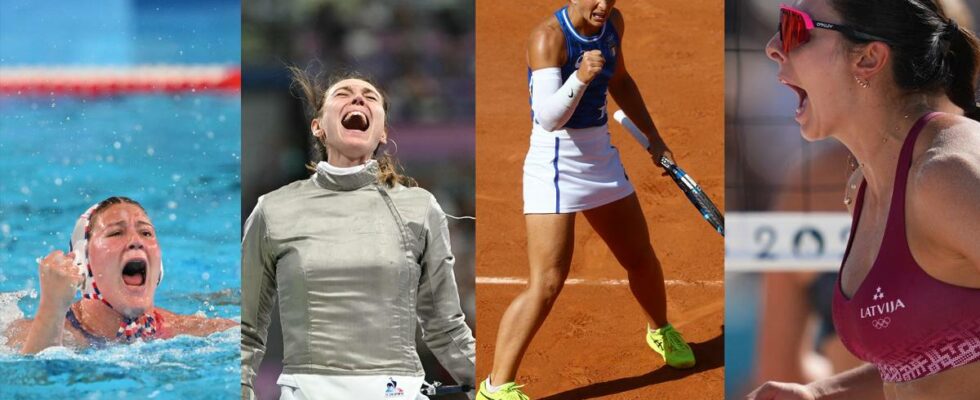– We are about to celebrate one of the most important moments in women’s history at the Olympic Games, and in sport in general, says IOC President Thomas Bach. The last time the French capital hosted the Olympic Games, 135 women competed out of a total of more than 3,000 athletes – a participation rate of around 4.4 percent. But in recent years, the work towards equality, on and off the field, has gained increased momentum in the Olympic movement. Thanks in part to initiatives by the International Olympic Committee (IOC). This has resulted in a record high number of women competing, with a new record of 48 per cent in Tokyo 2020. The Norwegian handball girls can celebrate both equality and the victory against South Korea on Tuesday. Photo: Beate Oma Dahle / NTB Historic Olympics And this year, more than a century after women first participated in the Olympics, the number of female athletes is for the first time equal to the men. – It means a lot. It is a job we have been very concerned about, and in our squad there are 47 per cent women, says the Norwegian sports president Zaineb Al-Samarai. The Norwegian Olympic squad this year consists of 109 athletes. Of these, 51 are female and 58 male athletes. Number of female athletes in the Olympics throughout history. Photo: IOC The Olympics in Paris are also the first Games where athletes with children have their own living room – a so-called “nursery room” for the smallest children. For the first time, there is also a separate room where mothers can breastfeed. A long road towards equality Women took part in the Olympics for the first time in 1900 in Paris, but only in tennis and golf. Since then, women have gradually gained access to more sports. In 1912, swimming was included, and in 1928 women were allowed to participate in athletics. But right up until 1976, women’s Olympic participation remained below 20 percent of the total number of competitors. In this 1924 file photo, American diver Elizabeth Becker competes during the women’s diving competition at the Paris Olympics. She won the gold medal. Only just over 4 percent of the athletes were women in 1924. Photo: AP Incredibly, it took until 2012 for women to be allowed to participate in all events on the Olympic program If we fast forward to 2024, there is actually a separate discipline in which only women participate, namely in rhythmic gymnastics. The IOC has also reorganized the broadcast schedule so that women’s events will air in prime time, while Olympic Broadcasting Services has increased the number of female commentators to 40 percent of the total. The Paris Olympics will also be the first to have a female closing ceremony, with the women’s marathon being the closing event. Zoe Verge-Depre prepares to serve in the women’s beach volleyball match between Latvia and Switzerland during the Olympic Games in Paris 2024. Photo: Mauro PIMENTEL / AFP But women are still underrepresented in the overall Olympic context. Women are still underrepresented in the boardroom as well as among the coaching staff. There has also never been a female president of the IOC, and only a third of the IOC’s executive committee are women. New initiative: Kindergarten for participants with children Nevertheless, the IOC can glimpse yet another ground-breaking news for the Olympics in Paris 2024, namely the introduction of a separate kindergarten. The Village Nursery, which opened last week, is intended to make it easier for athletes with families to participate in the Games. Allyson Felix, an American track and field star and member of the IOC Athletes’ Commission, was a strong voice in the project, which is sponsored by American baby care brand Pampers. Allyson Felix celebrates second place in the women’s 400 meters with her daughter Camryn at the 2021 U.S. Olympic Track and Field Trials. Photo: Ashley Landis / AP Felix’s departure from Nike in 2019 generated significant attention and put a spotlight on how female athletes are treated, especially when applies to pregnancy and motherhood. More and more athletes continue their careers after starting a family. Yesterday came the shock revelation that the Egyptian fencer Nada Hafez has taken part in the Olympics seven months pregnant. – What looked to you like two athletes on the podium were actually three. It was me, my opponent, and my future little baby, writes the Egyptian on his Instagram. – An important signal from the IOC Only among the Norwegian handball girls do seven of the players have children. Veronica Kristiansen gave birth to her first child in July last year, and the Olympics in Paris are the first championships she takes part in as a mother. – Facilitation is great. It is of course very good for those who need it and want it, says Kristiansen to news after the victory against South Korea in the group stage. The new rink garden measure means that athletes can book private or shared appointments at the facility. Here they have access to private areas for breastfeeding, a family lounge for play and a grooming area. – It is an incredibly important measure to keep our women longer, to be allowed to be both a mother and a performer, says Al-Samarai. Sports president Zaineb Al-Samarai has taken his five-month-old daughter Maja to the Summer Olympics in Paris. Photo: Geir Owe Fredheim / Norwegian Sports Confederation The sports president became a mother herself five months ago, and has brought her daughter Maja with her under her own guest accreditation. – I remember from my own career when I played football, that if you had children, then you were finished. Now it is no longer like that, and it is an incredibly important signal sent by the IOC, says Al-Samarai. Published 30.07.2024, at 14.07 Updated 30.07.2024, at 14.17
ttn-69
Paris 2024 sets new standards – news Sport – Sports news, results and broadcast schedule

